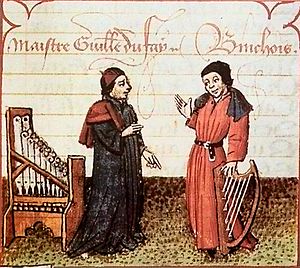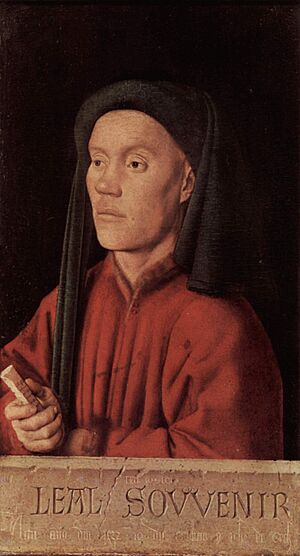Gilles Binchois facts for kids

Gilles Binchois (born around 1400 – died September 20, 1460) was an important composer from the early Renaissance music period. He was from the area between France and Belgium, known as Franco-Flemish. Binchois was a key member of the Burgundian School of music. He and his friend Guillaume Du Fay were greatly inspired by the "English style" of music, called contenance angloise, from John Dunstaple.
Binchois helped create a strong "Burgundian tradition" in music. This was very important for the later Franco-Flemish School. He is considered one of the three most famous composers of the early 1400s. While some experts today rank him just behind Du Fay and Dunstable, his music was still very popular. People copied, imitated, and used his songs as inspiration for many years after he died.
He was known for writing shorter, beautiful songs, especially his secular chansons (French songs). Even though he was famous for these, many of his religious songs have survived to this day. His music was known for its gentle rhythms, smooth melodies, and clever use of different notes that blended well together.
Contents
Life and Music Career
Early Life and Beginnings
Gilles Binchois' full name was Gilles de Bins dit Binchois. His parents were Johannes and Johanna de Binche. They were from a high-class family in Mons, a city in what is now Belgium. His father was a counselor for important leaders and churches. Gilles Binchois was likely born in Mons, too.
We don't know much about Binchois until December 8, 1419. At that time, he was working as an organist at a church called Ste Waudru in Mons. He probably learned music when he was young, perhaps as a choirboy.
Around 1423, he moved to Lille. Some records suggest he might have been a soldier for a short time. A special song written after his death hints at this. He might have served under an English leader during the Hundred Years' War.
Joining the Burgundian Court

In the late 1420s, Binchois joined the choir at the court of Burgundy. The exact date is not known because some old records are missing. We know he was there by January 18, 1431. He wrote a song called Nove cantum melodie for the baptism of a prince named Anthony.
The Burgundian court, led by Philip the Good, was a very important and lively place for arts and culture. It was known for its rich and varied artistic life.
Binchois was friends with Guillaume Du Fay, another leading composer of the time. They likely met in 1434 and definitely met in 1449 in Mons. Other important composers of his time included John Dunstaple and Leonel Power.
The Burgundian choir was special because its members could become church officials without being priests. In 1437, Binchois became a subdeacon. He received income from at least four churches until he died. Philip the Good also made him an honorary court secretary in 1437. Binchois didn't travel much on his own, according to the court's records.
Later Years in Soignies
Binchois retired in Soignies around February 1453. He received a good pension for his many years of service to the Burgundian court. In 1452, he became the head of the St Vincent church there. Soignies became known for its excellent music during this time.
Binchois might have been involved in a famous event in 1454 called the Feast of the Pheasant. A special song, Lamentatio sanctae matris ecclesiae Constantinopolitanae, was performed there. This song is usually thought to be by Du Fay, but some believe Binchois might have written it.
Gilles Binchois died in Soignies on September 20, 1460. After his death, another composer named Johannes Ockeghem wrote a sad song in his memory. It is also thought that Du Fay wrote a song called En triumphant to honor his friend.
His Music Style
Binchois is often seen as one of the best melody writers of the 1400s. His music had gentle, subtle rhythms and smooth, graceful melodies. He was very good at handling different notes that sounded good together, similar to his English friends.
His tunes were so popular that they were copied and used by other composers for decades after he died. Many of his secular (non-religious) songs are rondeaux. This was the most common song form during that century. Binchois' melodies often didn't strictly follow the rhyme scheme of the words, which was a bit unusual for composers back then.
Like Du Fay, Binchois was greatly influenced by the "English style" of music from John Dunstaple. The Burgundian court had good relationships with England, both in diplomacy and culture. This meant English musicians and ideas were welcome there.
About half of his surviving secular music can be found in a special old book called Oxford, Bodleian Library MS Canon. misc. 213.
His Legacy
Today, music experts generally agree that Binchois, along with Du Fay and John Dunstaple, were the three most important European composers of the early 15th century. Binchois is usually ranked just below the other two. Du Fay is often seen as the top composer of his time, and he wrote more music over a longer career. Dunstaple is considered one of the most influential English composers ever.
However, many experts believe that Binchois had a more direct impact on later music. His works were often borrowed, quoted, and used as inspiration by composers in the late 1400s. This shows how much his music was admired and used.
In the 20th century, two major collections of Binchois' music were published. Wolfgang Rehm edited his secular works in 1957, and Philip Kaye edited his religious music in 1992.
See also
 In Spanish: Gilles Binchois para niños
In Spanish: Gilles Binchois para niños

